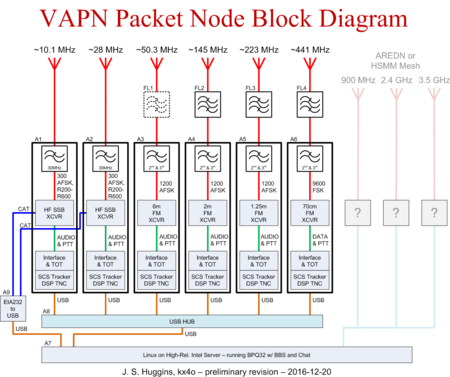Following our doctrine, the VAPN system includes:
- A traditional BBS node located alongside the radios at the hill top location;
- A variety of frequency access “ports” to capitalize on amateur radio’s most precious resource… radio spectrum;
- RF only, standalone system with no ties to the Internet;
- Access via one of the HamNet mesh systems if one evolves into a truly amateur radio only system;
- Adherence to FCC rule FCC Rule 97.113(5).
- Application of professional engineering in the design, rollout and maintenance of the VAPN following the guidance of accepted industry standards and practices where practical.
The hopeful result is a system providing a variety of ways to share information among amateurs via a common “node” using the time proven AX.25 protocol without pretending to be an Internet provider.
VAPN single-line block diagram
The high level diagram in the figure below is the design as it stands today. The power distribution is not shown for clarity.

Financial realities suggest the rollout of the above will be incremental. Which access bands come first are, but our operating 2m prototype on 145.030 MHz in the Warrenton, VA area suggests 2m will be first. The 900 MHz and above ports are based on user feedback of high speed COTS radios.
Hilltop radio room technical etiquette
In the amateur radio world, thrift is prevalent. That doesn’t apply to our systems sharing space with other commercial services. Proper application of “radio room” industry standards will be in the VAPN design from day one. If you are responsible for the repeater or other gear in someone else’s radio room, you want to be the one system the landlord is proud to show off. Some key attributes include:
- All amateur radios, computers, power systems (UPS), etc. are assembled into an EIA standard rack.
- All inputs and outputs into your rack are tied to a common point grounding panel – Rack Ground Bus (RGB) bar or panel. This includes power, signals and RF.
- The RGB is bonded to the building ground per the intent of the room’s designers – they usually provide a robust wire or a place to tie a robust wire.
- The RGB is bonded to each piece of equipment in the amateur rack with a stout grounding wire.
- Appropriate RF filtering a must not just for the amateur radio’s benefit, but to help prevent interference to other hilltop clients.
- Low PIM practices on every piece of coax, every antenna, and all mounting hardware. This means no dissimilar metals touching each other without proper thought. This means no Times Microwave LMR coaxial cable on the antenna side of any RF lines.
- Rackmount gear affixed in such a way that nothing slides around or falls out when tilting the rack 45 degrees in any direction. Laying gear on a rack shelf for anything beyond a quick test is unacceptable.
The above takes time and money to do correctly, but you only pay for quality once. The VAPN budget includes items to address all the above.